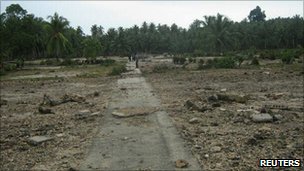BBC News, 27 October 2010 Last updated at 13:43 GMT
A crucial link in Indonesia's tsunami warning system was not working during Monday's tsunami because it had been vandalised, says an Indonesian official.
 |
| Whole villages were wiped out by the tsunami |
Hundreds of people were killed and many are missing as a result of the tsunami, which was generated by a magnitude 7.7 earthquake off the west coast of Sumatra.
The earthquake unleashed a 3m-high (10ft) wave that crashed into the remote Mentawai islands, levelling a number of villages.
Survivors have said no warning was given.
Ridwan Jamaluddin, of the Indonesian Agency for the Assessment and Application of Technology, told the BBC's Indonesian service that two buoys off the Mentawai islands were vandalised and so out of service.
"We don't say they are broken down but they were vandalised and the equipment is very expensive. It cost us five billion rupiah each (£353,000; $560,000).
Another official, from the Indonesian Climatology Agency told the BBC's Indonesian service that both tide gauges and buoys are used to detect a tsunami, but the buoys are more important to generating an early warning.
"To predict a tsunami, we need the data from the buoy and the tide gauge, which is located near the beach. The buoy is more important because it is on the sea, so it will record the wave much quicker that the tide gauge," said the official, named Fauzi.
Difficulties
Residents of the Mentawai islands have told the BBC they heard no tsunami warning.
"There was not any siren to warn people in Sikakap [a small town on North Pagai island]," said Ferdinand Salamanang.
"Yes there was a quake and tsunami detection system in our port, but they are broken down. We did not hear any warning this time."
Almost exactly two years ago Indonesia launched its new tsunami early warning centre, designed to give people in coastal areas enough time to escape any waves before they reach land.
- Recorder on seabed measures pressure and sends data to buoy.
- Buoy also detects changes in sea level and motion. Tide gauges, usually sited on land, detect tidal changes.
- Information is transmitted via satellite to ground stations which assess risk of tsunami.
The project was launched after the devastating Indian Ocean tsunami, which hit the country in 2004.
A quarter of a million people on the ocean shores died, more than half of them in the Indonesian province of Aceh, on the northern tip of Sumatra and close to the earthquake's epicentre.
The system was meant to be completed in 2010 but it is still a work in progress, says Tiziana Bonapace, a disaster risk specialist with the UN.
"Earthquake and sea-level monitoring systems are in place, but what has proven more difficult is how to get warnings out to remote areas in time," she told the BBC.
"This remains the weakest link in the system, and unfortunately the tsunami hit one of the farthest outlying islands. Further exacerbating the situation is that buoys do malfunction, and many countries have been experiencing difficulties in this regard."
'Too late'
A more difficult challenge, she said, was instilling at the community level an awareness of the potential for disasters and how to prepare for them.
Even if the system had been fully functioning, the earthquake struck so close to the islands that an alert may not have given residents enough time to escape.
"Pagai island is very close to the epicentre, so the waves reached Pagai island in just five or 10 minutes," Ridwan Jamaluddin said.
"Even if the buoy is on, it is still too late to warn the people."
That view is echoed by Andrew Judge of SurfAid International, a humanitarian agency that has worked in the area for 10 years.
"The distance from the epicentre was very short... there's no time to act" on an alert, he told the BBC.
The Mentawai islands are very remote and communications are very difficult, he said. "Those people wouldn't have been reached by an alert."
Related Articles:
